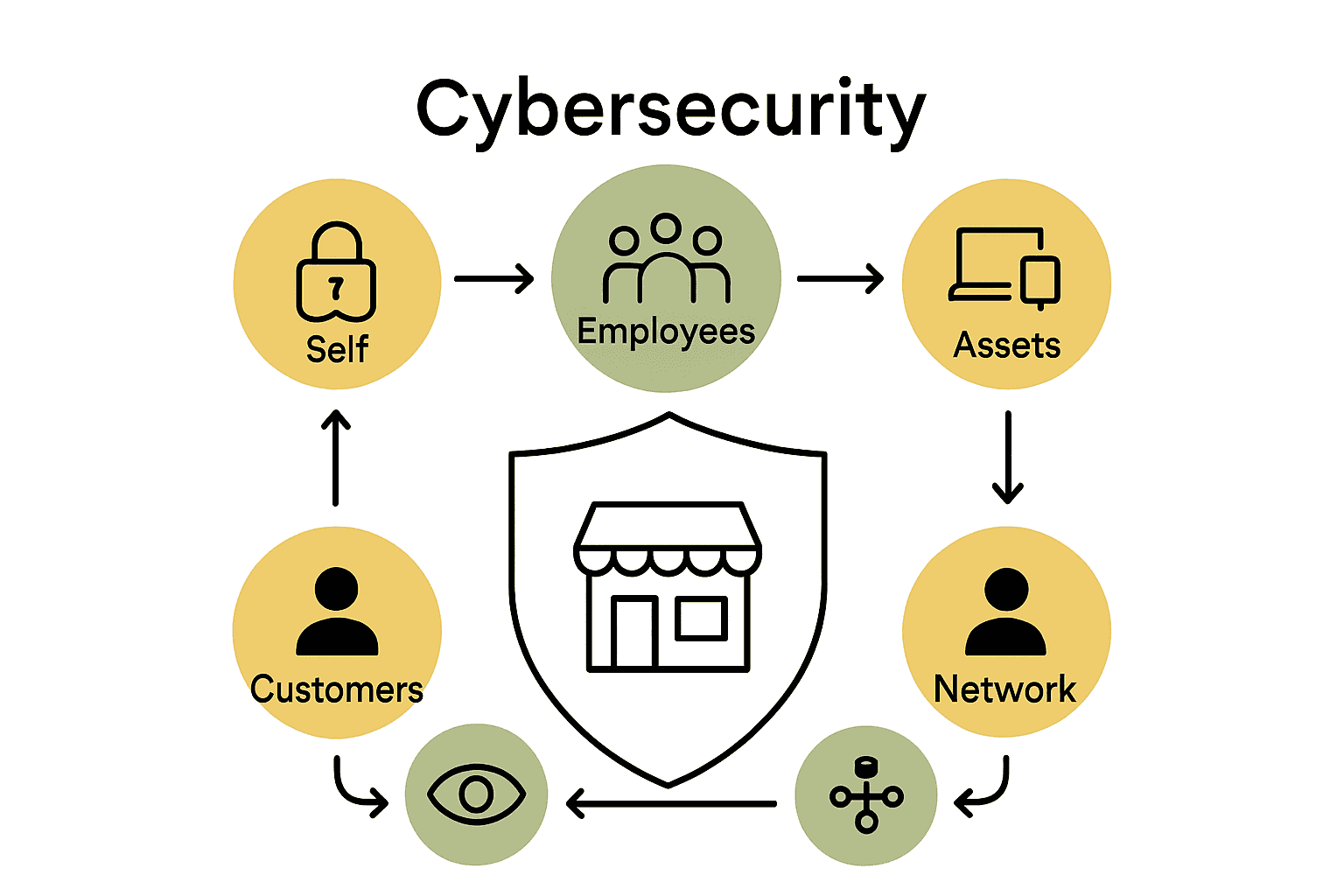Did you know that over 60 percent of small businesses experience a cyberattack each year? Cybercriminals see smaller firms as prime targets because they often lack strict digital defenses. Protecting your company goes far beyond installing antivirus software. Learning how to guard customer data and keep your operations safe can make the difference between thriving and struggling to recover from a costly breach.
Key Takeaways
| Point | Details |
|---|---|
| Cybersecurity Importance | Small businesses must prioritize cybersecurity to protect digital assets, customer information, and reputation from online threats. |
| Six-Layer Approach | Implement the SEANCE Cybersecurity Framework’s six layers: Self, Employees, Assets, Network, Customers, and Environment for a comprehensive strategy. |
| Threat Awareness | Be vigilant against potential threats like ransomware, AI-powered phishing, and cloud configuration errors, as these pose significant risks. |
| Legal Responsibilities | Small businesses must adhere to cybersecurity regulations and develop proactive data protection strategies to avoid severe penalties. |
Table of Contents
- Defining Cybersecurity For Small Business
- Common Threats Facing Small Businesses
- Essential Security Measures And Tools
- Understanding Legal And Data Protection Duties
- Costs, Risks, And Avoiding Common Mistakes
Defining Cybersecurity for Small Business
Cybersecurity isn’t just a complex technical term reserved for large corporations. For small businesses, it’s about protecting your digital assets, customer information, and business reputation from potential online threats. Cybersecurity fundamentally means creating strategic defenses that safeguard your business’s digital ecosystem against unauthorized access, data breaches, and malicious attacks.
According to research from the SEANCE Cybersecurity Framework, small businesses can adopt a straightforward six-layer approach to understanding their cybersecurity needs. This framework breaks down protection into manageable components:
Here’s a summary of the six-layer approach to small business cybersecurity:
| Layer | Focus Area | Example Actions |
|---|---|---|
| Self | Personal awareness | Strong passwords Secure devices |
| Employees | Team training & protocols | Security workshops Phishing tests |
| Assets | Tech resources protection | Asset inventory Device encryption |
| Network | Internet & data security | Firewalls Wi-Fi protection |
| Customers | Safeguarding client data | Data privacy policy Secure payments |
| Environment | Broader digital threats | Risk assessments Vendor vetting |
- Self: Your personal digital awareness and practices
- Employees: Training and protocols for team digital safety
- Assets: Identifying and protecting digital and physical technology resources
- Network: Securing internet connections and data transmission
- Customers: Protecting client information and trust
- Environment: Understanding broader digital risks in your business context
The academic research proposing the Small IT Data (SITD) model emphasizes that cybersecurity isn’t about implementing complex, expensive systems. Instead, it’s about making strategic, proportionate decisions aligned with your specific business needs. Small businesses can start by:

- Assessing current digital vulnerabilities
- Implementing basic protective measures
- Training team members on digital safety
- Regularly updating security protocols
Think of cybersecurity like a digital lock system for your business – it doesn’t need to be impenetrable, just smart and consistent. By understanding these foundational principles, you’re already taking significant steps to protect your business’s most valuable digital assets.

Common Threats Facing Small Businesses
Small businesses face an increasingly complex landscape of digital threats that can compromise their operations, finances, and reputation. According to recent cybersecurity research, the stakes are higher than ever: 61% of small businesses were targeted by at least one cyberattack in recent years, with the average breach costing a staggering US$164,000.
The emerging threat landscape includes sophisticated attacks that go far beyond traditional hacking. Cybersecurity experts have identified several critical risks small businesses must watch for:
- AI-Powered Phishing: Automated attacks that adapt and become more convincing
- Ransomware-as-a-Service: Pre-built malicious software available to less technical criminals
- Deepfake Impersonation: Advanced technology creating fake communications
- IoT Device Exploitation: Vulnerable smart devices as entry points for attackers
- Cloud Configuration Errors: Unintentional vulnerabilities in cloud infrastructure
Most alarming is that ransomware now accounts for 37% of all cybersecurity incidents. Many small businesses lack dedicated cybersecurity personnel, making them particularly vulnerable.
This means a single attack could potentially cause substantial operational downtime, financial loss, and long-term reputation damage. Read our guide on digital marketing trends to understand how staying informed can help you protect your business proactively.
Essential Security Measures and Tools
Protecting your small business from cyber threats requires a strategic, comprehensive approach. The NIST Cybersecurity Framework provides an internationally recognized roadmap that breaks down cybersecurity into five critical functions: Identify, Protect, Detect, Respond, and Recover. Think of this as a digital safety blueprint that helps businesses systematically build their defense strategy.
In the Identify phase, businesses map out their digital assets and potential vulnerabilities. This means conducting a thorough inventory of:
- Digital systems and networks
- Data storage locations
- Access points
- Potential weak spots in your infrastructure
The Protect stage involves implementing robust security measures. Continuous Exposure Management technologies can help small businesses monitor and prioritize potential vulnerabilities across cloud and on-premises environments. Key protective tools include:
- Firewall configurations
- Multi-factor authentication
- Encrypted data storage
- Regular software updates
- Employee cybersecurity training
Detection and response mechanisms are equally crucial. Small businesses should invest in real-time monitoring tools that can quickly identify suspicious activities, allowing for rapid intervention before potential breaches escalate. Our guide on digital marketing trends also offers insights into staying technologically adaptive and secure in a rapidly changing digital landscape.
Understanding Legal and Data Protection Duties
Cybersecurity is no longer just a technical issue – it’s a legal responsibility that can have significant financial consequences for small businesses. According to international regulatory trends, businesses are increasingly required to demonstrate proactive data protection strategies and robust cybersecurity measures.
Financial Times research highlights a global shift toward stricter cybersecurity compliance, with regulations like the EU’s NIS2 and new US cybersecurity initiatives pushing businesses to adopt zero-trust models. These frameworks require companies to:
- Integrate security into core operational processes
- Maintain comprehensive breach response plans
- Continuously verify and authenticate digital interactions
- Implement strict access control mechanisms
The potential financial risks are substantial. For instance, Australian regulatory reports demonstrate that data breach penalties can range from A$15,000 to A$2.1 million for serious or repeated violations. This means even small businesses cannot afford to ignore their legal data protection obligations.
Navigating these complex requirements might seem overwhelming, but starting with a solid privacy policy and understanding your specific industry’s regulations is crucial. Treat data protection as an ongoing commitment, not a one-time checkbox exercise. The goal is building trust with your customers while protecting your business from potentially devastating legal and financial repercussions.
Costs, Risks, and Avoiding Common Mistakes
Cybersecurity isn’t just a technical challenge – it’s a critical financial consideration for small businesses. Recent financial research reveals that the average cost of a data breach in 2023 reached a staggering US$4.45 million, with small businesses particularly vulnerable to these potentially devastating financial impacts.
According to Australian cybersecurity experts, small businesses face an average incident cost of A$50,000, primarily driven by:
- Configuration errors in digital systems
- Outdated software and hardware
- Inadequate employee training
- Weak password management
- Lack of comprehensive backup strategies
The most common cybersecurity mistakes small businesses make include:
- Assuming they’re too small to be targeted
- Neglecting regular software updates
- Using weak or repeated passwords
- Failing to train employees on basic security protocols
- Not implementing multi-factor authentication
To mitigate these risks, businesses should adopt a proactive approach. Learn more about digital marketing strategies that can help you stay technologically secure while growing your business. Remember, investing in cybersecurity isn’t an expense – it’s protection against potentially catastrophic financial and reputational damage.
Turn Cybersecurity Awareness Into Business Growth With Expert Support
Learning how hackers target small businesses and understanding the need for strong cybersecurity is only the first step. You want to defend your data and safeguard your reputation, but often the real challenge is turning these security basics into daily practice without draining your time or budget. The fear of costly breaches, legal risks, and damaged customer trust can keep business owners up at night.

Let ibrand.media help you put your new knowledge into action. We go beyond digital marketing—we align website protection, secure web design, and data privacy with your growth goals. Our tailored plans cover more than just promotion. We build solid, secure foundations so your business can thrive online without worry. Make your next move count. Visit our homepage or check Uncategorized | Ibrandmedia for more resources. Ready to boost your security and online presence now? Connect with ibrand.media for guidance you can trust and tangible results you can measure.
Frequently Asked Questions
What is cybersecurity for small businesses?
Cybersecurity for small businesses refers to the strategies and measures implemented to protect digital assets, customer information, and business reputation from online threats, such as unauthorized access and data breaches.
What are the common threats facing small businesses in terms of cybersecurity?
Common threats include AI-powered phishing, ransomware-as-a-service, deepfake impersonation, IoT device exploitation, and cloud configuration errors, all of which can significantly impact operations and financial stability.
What essential security measures should small businesses implement?
Small businesses should focus on measures like firewalls, multi-factor authentication, encrypted data storage, employee training, and regular software updates to enhance their cybersecurity posture.
How can small businesses understand their legal and data protection responsibilities?
Small businesses should be aware of increasing regulations that require proactive data protection strategies. This includes maintaining comprehensive breach response plans, implementing strict access controls, and integrating security into core operations.
Recommended
- creating a brand for small businesses | Ibrandmedia
- Digital Marketing Basics for Small Businesses in 2025 | Ibrandmedia
- Top Digital Trends for Small Businesses in 2025 | Ibrandmedia
- What Is Digital Marketing? A Simple Guide for Small Businesses (2025) | Ibrandmedia
- 10 Affordable Workplace Security Tips | 247 CCTV
- Transform42 New

Recent Comments